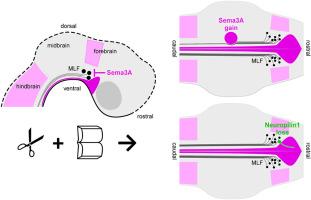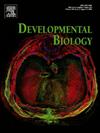Semaphorin 3A repulsion directs the caudal projection of pioneer longitudinal axons in the developing chicken brain
IF 2.1
3区 生物学
Q2 DEVELOPMENTAL BIOLOGY
引用次数: 0
Abstract
The medial longitudinal fasciculus (MLF) is the first axon tract to develop in the ventral vertebrate brain. It originates in the diencephalon and projects caudally into the spinal cord, pioneering the path for later developing axons. Previous anatomical and expression analyses in the chicken suggested Semaphorin 3 A (Sema3A) as the candidate to repel the amniote MLF from the forebrain. However, studies in the zebrafish implicated a distantly related semaphorin with a role in axon fasciculation, not guidance. Thus, the mechanism accounting for the caudal projection of the MLF remains unclear.
Here we show that misexpression of Sema3A or grafting of Sema3A-expressing cells into the path of the MLF diverts the axons or blocks their outgrowth in chicken embryos. In vitro, Sema3A exposure resulted in the collapse of MLF growth cones. A dominant-negative approach or siRNA to interfere with the function of the Sema3A receptor Neuropilin1 allowed MLF axons to project rostrally. Together, this suggests that Sema3a repulsion directs the caudal extension of the MLF to pioneer the ventral longitudinal tract.

信号蛋白3A排斥力指导发育中的鸡脑先锋纵向轴突的尾侧投射
内侧纵束(medial longitudinal fasciculus, MLF)是腹侧脊椎动物大脑中最早发育的轴突束。它起源于间脑,尾侧投射到脊髓,为后来的轴突发育开辟了道路。先前对鸡的解剖和表达分析表明,信号蛋白3a (Sema3A)是将羊膜MLF从前脑排斥的候选基因。然而,对斑马鱼的研究表明,一种与轴突束状突起有远缘关系的信号蛋白在轴突束状突起中起作用,而不是引导作用。因此,解释MLF尾侧投射的机制仍不清楚。本研究表明,在鸡胚胎中,Sema3A的错误表达或将表达Sema3A的细胞移植到MLF通路中会使轴突发生转移或阻断其生长。在体外,Sema3A暴露导致MLF生长锥体塌陷。siRNA干扰Sema3A受体Neuropilin1功能的显性阴性方法允许MLF轴突向侧投射。综上所述,这表明Sema3a排斥力引导MLF的尾侧延伸,以开拓腹侧纵束。
本文章由计算机程序翻译,如有差异,请以英文原文为准。
求助全文
约1分钟内获得全文
求助全文
来源期刊

Developmental biology
生物-发育生物学
CiteScore
5.30
自引率
3.70%
发文量
182
审稿时长
1.5 months
期刊介绍:
Developmental Biology (DB) publishes original research on mechanisms of development, differentiation, and growth in animals and plants at the molecular, cellular, genetic and evolutionary levels. Areas of particular emphasis include transcriptional control mechanisms, embryonic patterning, cell-cell interactions, growth factors and signal transduction, and regulatory hierarchies in developing plants and animals.
 求助内容:
求助内容: 应助结果提醒方式:
应助结果提醒方式:


